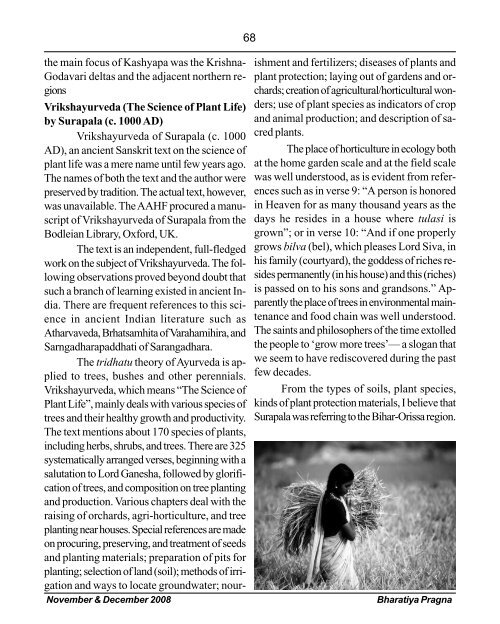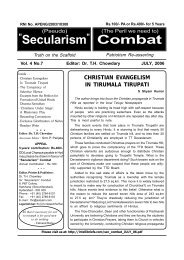Bharatiya Pragna - Dr. Th Chowdary
Bharatiya Pragna - Dr. Th Chowdary
Bharatiya Pragna - Dr. Th Chowdary
You also want an ePaper? Increase the reach of your titles
YUMPU automatically turns print PDFs into web optimized ePapers that Google loves.
68<br />
the main focus of Kashyapa was the Krishna- ishment and fertilizers; diseases of plants and<br />
Godavari deltas and the adjacent northern re- plant protection; laying out of gardens and orgionschards;<br />
creation of agricultural/horticultural won-<br />
Vrikshayurveda (<strong>Th</strong>e Science of Plant Life) ders; use of plant species as indicators of crop<br />
by Surapala (c. 1000 AD)<br />
and animal production; and description of sa-<br />
Vrikshayurveda of Surapala (c. 1000 cred plants.<br />
AD), an ancient Sanskrit text on the science of <strong>Th</strong>e place of horticulture in ecology both<br />
plant life was a mere name until few years ago. at the home garden scale and at the field scale<br />
<strong>Th</strong>e names of both the text and the author were was well understood, as is evident from refer-<br />
preserved by tradition. <strong>Th</strong>e actual text, however, ences such as in verse 9: “A person is honored<br />
was unavailable. <strong>Th</strong>e AAHF procured a manu- in Heaven for as many thousand years as the<br />
script of Vrikshayurveda of Surapala from the days he resides in a house where tulasi is<br />
Bodleian Library, Oxford, UK.<br />
grown”; or in verse 10: “And if one properly<br />
<strong>Th</strong>e text is an independent, full-fledged grows bilva (bel), which pleases Lord Siva, in<br />
work on the subject of Vrikshayurveda. <strong>Th</strong>e fol- his family (courtyard), the goddess of riches relowing<br />
observations proved beyond doubt that sides permanently (in his house) and this (riches)<br />
such a branch of learning existed in ancient In- is passed on to his sons and grandsons.” Apdia.<br />
<strong>Th</strong>ere are frequent references to this sciparently the place of trees in environmental mainence<br />
in ancient Indian literature such as tenance and food chain was well understood.<br />
Atharvaveda, Brhatsamhita of Varahamihira, and <strong>Th</strong>e saints and philosophers of the time extolled<br />
Sarngadharapaddhati of Sarangadhara. the people to ‘grow more trees’— a slogan that<br />
<strong>Th</strong>e tridhatu theory of Ayurveda is applied<br />
to trees, bushes and other perennials.<br />
we seem to have rediscovered during the past<br />
few decades.<br />
Vrikshayurveda, which means “<strong>Th</strong>e Science of From the types of soils, plant species,<br />
Plant Life”, mainly deals with various species of kinds of plant protection materials, I believe that<br />
trees and their healthy growth and productivity.<br />
<strong>Th</strong>e text mentions about 170 species of plants,<br />
including herbs, shrubs, and trees. <strong>Th</strong>ere are 325<br />
systematically arranged verses, beginning with a<br />
salutation to Lord Ganesha, followed by glorification<br />
of trees, and composition on tree planting<br />
and production. Various chapters deal with the<br />
raising of orchards, agri-horticulture, and tree<br />
planting near houses. Special references are made<br />
on procuring, preserving, and treatment of seeds<br />
and planting materials; preparation of pits for<br />
planting; selection of land (soil); methods of irrigation<br />
and ways to locate groundwater; nour-<br />
Surapala was referring to the Bihar-Orissa region.<br />
November & December 2008 <strong>Bharatiya</strong> <strong>Pragna</strong>



